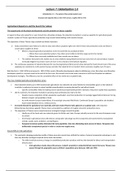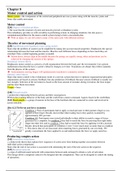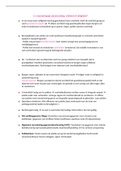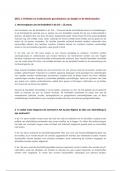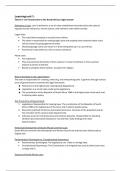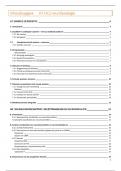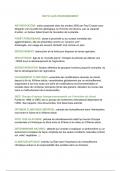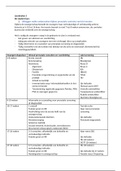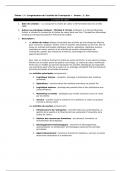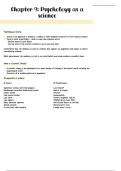Globalization 1.0 – The period of freer global markets and
financial and migration flows in the 19th century, roughly 1850 to 1914
Agricultural Exporters and the Search for Labour
The opportunity of Ricardian development and the problem of labour supplies
In regard to those who opted for or were forced into a Ricardian strategy, the industrial revolution’s voracious appetite for agricultural goods
created a system of Thunen agricultural production rings around industrializing north-western Europe.
The expansion of those Thunen rings created two distinct dynamics:
1) States everywhere used violence in order to seize and enforce property rights over land in these new production zones and then to
create labour supplies for them:
Efforts to expand agricultural production zones encountered two paradoxical limits:
o Where there were potential workers, they often were hostile to full-time wage work in the market.
o Where there was easily available land, there usually was no labour.
The solution favoured by the market was to seize relatively unpopulated land and use some form of coerced labour. Exports
eventually triggered successive waves of more or less voluntary international migration.
2) The continuous expansion of industrial demand for non-food agriculture (NFAs) and of urban demand for foods forced most of the areas
supplying raw materials to north-western Europe and alter the industrial US to transform their economies roughly every 50 years.
Both the first (c. 1850-1870s) and second (c. 1890-1920s) round of Ricardian development ended in deflationary crises. But where most Ricardian
developers opted for a second round at the end of the first crisis, the second crisis forced some countries to shift from Ricardian to Kaldorian
development strategies. The difference was the cumulative effect of two world wars on global trade.
The rise of global agricultural production zones
Most industrial activity up to WWI transformed agricultural raw materials into some finished or intermediate good, so the industrial
revolution’s explosive increases in output implied proportionately increasing demand for agricultural inputs.
o Specific commodities linked to leading sectors experienced exponential growth in demand, rising more rapidly than population.
Like its machines, the industrial revolution’s growing urban proletariat also had to be fed:
o Despite massive emigration, Britain population quadrupled. Local food production increasingly lagged behind demand, forcing
Britain to import vast quantities of food.
o As north-western Europe industrialized, it increasingly consumed like Britain. Continental Europe’s population also doubled.
Asian industrialization drove a similar process.
Increased demand for agricultural raw materials and food created Thunen-style agrizones on a global scale, with industrial
Britain/Europe becoming a gigantic Thunen town surrounded by a plethora of roughly concentric production zones.
The expansion of Thunen zones caused enormous ecological changes around the globe:
o Hardly any of the foods and raw materials grown for Britain and, later, Europe naturally occurred in the areas Europeans came
to control.
o All of today’s agricultural areas with obvious comparative advantage was first conquered and transformed by transplanted
animals, weeds, pests, predators, and pathogens.
o European incursions quickly eliminated the local population, thus also eliminating local sources of labour. Europeans also
deliberately transplanted species in order to create new supply areas.
Zonal shifts in Irish agriculture
The constantly changing production profile of these areas also reveals how artificial the notion of natural comparative advantage is, and
thus why Ricardian strategies required active state intervention.
o The shifts involved enormous changes in established production practices and thus the demand for labour and transportation
infrastructure.
Irish agriculture clearly shows this process. Ireland’s proximity to industrial Britain meant that every Thunen zone
passed through its geographic space as Britain’s population grew between 1600 and 1900.
, As transportation links improved and as Britain’s population grew, pushing agrizones offshore, Irish agricultural production processes,
population, and exports changed.
o Each transportation improvement and increase in British demand brought Ireland one ring closer towards the English town,
changing production and increasing the value added per acre.
o The Irish story reflects a complex interplay between market opportunities and local action.
Ireland became part of the outermost grazing ring, supplying range-fed cattle to England:
o Anglo-Irish landlords expanded their production of low-quality beef to the point where they posed a competitive challenge for
English producers
o As response, the English closed their market to non-mainland producers:
This action diverted Irish beef exports to the Royal navy and to the West Indian colonies, which were being
repopulated with Irish convict labour and enslaved Africans.
From 1700 on, the number of cattle increased rapidly as these markets grew. The Irish peasantry found its diet shifting form oats to
potatoes which allowed for a better caloric intake:
o This permitted landlords to compress the peasantry into a smaller area while freeing up land from non-subsistence uses. The
population increased slowly, and all ate potatoes, so all the meat was exported.
During the 1700s, the British population doubled so Britain became a consistent net grain importer. Politics and location made Ireland the
major supplier of these grain imports, and grain soon displaced beef as Ireland’s major export.
o Rising grain exports presented Anglo-Irish landlords with a dilemma:
In order to grow more grain, they had to push cattle and peasants off the land, but to harvest that grain they needed
more seasonal labour:
So, they compressed the peasantry’s smallholdings even more forcing them to exclusively rely on the
potato.
The interaction between rising grain production and rising potato consumption on a shrinking area reached its
natural limits in the 1840s during the Famine.
All this led to Ireland’s last, longest, and greatest rebellion against the English, as well as continued
migration.
Agricultural production zones and the problem of labour
European industrialization recreated Ireland’s experience around the world:
o Agricultural production rings rippled outward, but with one key difference:
The best places to produce temperate agricultural goods lacked any significant population, and the second-best
places lacked a willing labour force.
The absence of labour slowed the transformation of available land into supply zones for Europe.
The state-sponsored expansion of modern industry in Europe created huge new demands for raw materials to feed machines and the
new urban proletariat:
o Cheap land for production largely lacked willing labour. So, most production in the New World and Asia relied on some form of
involuntary labour:
States mobilized labour by supporting slavery, indenture, and then by promoting voluntary immigration. States and
settlers in the periphery had to deploy organized violence and start production with non-capitalist labour forms:
Frontiers, workers, and coercion: Why was there a labour shortage, why use coerced labour, and why did coercion give way to
nominally free labour later in the 1800s?
o It was relatively expensive to subdue native populations and states in areas with high-density populations as compared to
Europe.
But in areas with lower population densities, free immigrant labour might simply melt into the countryside.
Coerced labour was cheaper and less risky than paying free labour to migrate.
o Would-be agricultural capitalists faced a dilemma:
Empty places, places without a rooted peasantry, landlords, and a state, were the cheapest places for production:
As it happened, most of the empty places were in temperate climate zones in the Americas, Australasia, and
southern Africa.
Africa suited for the bulk of the foods and NFAs that European devoured:
o Settlers and disease killed off most of the local population. But open frontiers in those empty
lands meant that labour could simply disappear over the frontier and take land.
In full places, with their high population density, would-be capitalists had access to labour. But they faced
considerable political, social and police costs of controlling the peasantry and acquiring land.
,Hegemony and the end of British hegemony: Production, trade, finance
Hegemony cycles (upswings and downswings in hegemonic power dominance over military, financial, trading power). These three
elements are not always in congruence, sometimes if your military is declining, your financial power might actually be increasing.
Political-economic hegemony?
The source of dominance comes from four different domains:
1) Consumption – Developed domestic market:
Typically, the hegemon is the dominant entity in consuming, the rich part of the world. This creates a large demand.
o The large demand has two benefits:
First of all, the country has a big internal market that it can produce for.
And also, imports. If you are the hegemon and your people are buying products from other countries, then
it means that you also determine what exactly is produced in other parts of the world. It is not only about
the exact product, but also about the quality of the product and the rules to be followed when producing it.
2) Production and export – Leading sectors:
The hegemonic power builds on a particular leading sector which generates a lot of profit and high exports.
3) Investment – Direct Capital flows
4) Money and finance – Global currency
Having a currency in which everything or at least the big majority is traded.
Long-term interest of the hegemon coincide with the way the international economy system is structured. However, it is not fully static. It is not
the case that we will live in the dame system for ever and ever, as hegemony comes in cycles.
British Hegemony
First-mover advantage during industrialization:
o Superiority in the manufacture of textiles and railroad-linked goods – the first two Schumpeterian leadings sectors – was the
bedrock for its hegemony during the 19th century
Result: dominance in all three domains (trade, finance, production)
London Global Financial Centre:
o Global capital flows through British hands; profits for British banking sector
o Being the hegemon, where all the best production happens and all the money flow, it allows for an Arbitrage:
Foreign capital flows into London at low interest rates (because London = trustworthy)
London lends out this money to foreign markets at high interest rates (because others are less trustworthy)
Position of arbitrage: You are somewhere in-between where all the financial flows come through you, it is s a
brokering position where you are and can extract a fee from that.
o Outcome: Countries dependent on British banking sector
Hegemony also arises from the convergence of interests between specific groups making state policy in the subordinated countries and
those making policy in the hegemon, and is solidified in costly to reverse investment decisions and habits of the minds.
,The erosion of British Hegemony from Below: Dominance of Production – The British miss out on key innovations
Ultimately British hegemony eroded because its productive base eroded relative to that of its two main competitions, Germany and the United
States.
Hard technologies and firm structures:
o Economies of scale:
Economies of scale come from using the same highly specialized machinery to produce enormous quantities of the
same standard product.
The new process technologies required enormous investment in product-specific production and transportation
equipment. These investment were only profitable if plants could run at high levels of capacity utilization and
throughput.
The British had innovated, but their industry was still pretty much family based, with smaller factories and important
limits.
o Economies of scope:
Systemic research and development created possibilities for economies of scope. These come from using the same
knowledge to produce similar products.
Firms with dedicated research and development facilities could apply knowledge to a new wide range of foods, like
organic chemicals and then driving costs down.
The first university-industry complexes, forerunners of areas like Silicon Valley, started in Germany’s chemical
industry and in US agriculture.
The professionalization of management – Soft innovation:
o The multidivisional firm was the only type that could adequately capture these economies of scale and scope:
These new firms first emerged in the US because of the difficulties railroads encountered managing continental-scale
operation.
o The new US and German multidivisional firms were bigger than, and handled management, marketing and manufacturing
differently from Britain’s family-run firms.
In turn these firms also needed marketing professionals in order to develop stable consumer markets for high levels
of output, and also reorganize manufacturing processes to present workers from interfering with the optimization of
production flows.
The cartelization of competition:
o Dominance of England went very well together with free trade in the international trading system.
o An amalgamation of many small firms into a few larger firms permitted larger investments in these new technologies:
But too many small firms flooding the market could drive down prices and eliminate any profit.
o Cartelization:
A cartel is an organization created from a formal agreement between a group of producers of a good or service to
regulate supply to regulate or manipulate prices without competition
o Cartelization took different legal and financial forms in the US and Germany:
In US it actually became illegal to create these so-called trusts. So, US firms had to merge their organizations into one
company if they wanted to control prices without facing prosecution:
In the long run ,this approach actually enhanced the US competitive position in the world markets by
forcing and allowing for a more thorough reorganization of production.
In Germany it was legal and cartel agreements were enforceable contracts:
This enhanced German banks’ power. These were larger usually than firms and so used their control over
access to capital to persuade owners to participate into cartels.
o These cartels took advantage of state policies that protected industry through high tariffs and helped them to maximize scale
economies through military purchasing:
High tariffs enabled cartels to capture their local market and then use that as a platform for expanding into foreign
markets.
o British firms amalgamated more hesitantly and their slowness in adopting new organizational forms led to glaring
differences in the production of one of the key goods of the era, steel:
Meanwhile, the US and Germany continued building railroads at high volumes.
US and German metals producers thus benefited much more form Verdoorn effects than did the British.
The electrification of production:
, o Chemical innovation, electricity, oil, steel 2.0 (hard innovations):
Electrification of production overcame many of the limitations inherent in steam-powered machinery.
Electrically powered equipment in the steel industry replaced human-powered charging and draining of the furnace,
allowing bigger furnaces to run continuously.
Most innovations came from the UK, but they were not able to turn these into a new leading sector
o German and US metal smelting firms built larger-scale production facilities because this enabled them to use electrically driven
machinery to attain higher throughput:
This passed Verdoorn effects on to the electrical goods industry, spurring its growth.
o Again, British electrical goods firms had to sell to a low-growing metals industry whose scale of production did not justify such
machinery:
Because firms were family owned they could not afford to shut down what often was their only furnace to reorganize
production around the new technologies.
The Taylorization of work processes:
o Electrification only boosted productivity if work processes could also be changed to take maximum advantage of electrical
machinery.
o Taylor based division of labor:
Scientific management. You look at a production process and try scientifically to make it as efficient as possible.
Measure, monitor, evaluate.
Management needed to reduce or remove workers’ ability to control the flow of materials and the pace of work in
order to make electrification profitable.
Existing work processes in the steel and related industries gave workers considerable control over output
levels.
Dialectics of lead
o Law of the handicap of a head start (coined by Jan Romein, 1937)
Sometimes if you are in the lead of everybody, it may be to your disadvantage as you cannot actually see if
something is going wrong if it does not immediately have a major impact.
The end of British Hegemony (And Globalization 1.0):
o UK loses hegemony in production (in relative terms!) but retains it in financial markets
o UK: slow but steady increased dislike of free trade (no longer fair...)
o Financial elite remains in favor of free trade
o UK retreats in colonial empire
o How long will the British continue to promote free trade against the background of increasing competition?
Globalization and the debt crises
Agriculture-Led Growth and Crisis in the Periphery
Ricardian Success, Ricardian Failure
The cyclic expansion of industrial country output engendered similarly sized expansion of peripheral agricultural production. States
violently created new production zones in successive waves, inducing the massive waves of involuntary and voluntary migration.
But the opportunity to produce agricultural goods for an industrial core guaranteed neither exports nor development. Value produced
per acre was necessarily low out in the periphery. While trade flows were complementary and fairly stable, the investment flows that
accompanied them were not.
Looking at the periphery, at the unit level: Different state policies created different outcomes in the periphery as peripheral states
responded to their common Gerschenkronian and Kaldorian collective action problems.
Looking at the system level: As in industrial Europe, relative success for some developers meant failure for other.
The Failure of Ricardian strategies: The crises of the 1890s
The crisis of the 1980s was a debt crisis with simultaneously international and domestic causes and ramifications, Moreover, it set the basic pattern
for subsequent global debt crises.
,Ricardian debt crises: systemic factors and solutions
It is necessary to understand how money was lent, and why it was borrowed.
19th Century offshore investment was enormous, even by today’s standards:
o Between 1873 and 1914 the British invested an average 5 per cent of their GDP overseas, enabling Australia, Argentina, Canada,
and other nations to finance between 30 and 50 per cent of their gross capital formation from overseas sources.
Europe, and particularly Britain, lent so much money because ex ante returns looked large:
o The division of labour could expand as fast as supply of food and raw materials for urban workers and manufacturing activity
expanded.
o Manufacturing output and its labour force expanded more rapidly than agricultural production through most of the 1800s,
raising relative prices and profits for agricultural goods.
High agricultural prices made would-be agricultural exporters out in the NACs (Non-agricultural count willing to pay
relatively high interest rates to get capital, and lenders quite reasonably invested for maximum return.
o These dynamics created a perpetual tendency towards oversupply and thus a debt crisis or a profitability crisis (from the
point of view of borrowers) as prices cycled downwards.
Differences between the social structures of European agricultural production and NAC production made NAC agricultural production
more profitable than European production, even after transportation costs.
Lagging European agricultural productivity produced a highly complementary investment and trade pattern in which western European
industry spun off some of its profits into high productivity agriculture largely outside Europe, thus lowering its raw materials and food
costs, and enabling even higher industrial profits and more investment:
o Investment occurred in sequential waves toward whichever geographic area seemed the most promising location at that time:
States, local entrepreneurs, and a bevy of bi-national corporations controlled the actual deployment of capital.
o Over 70 per cent of this lending was in the form of portfolio investment in which lenders do not control the enterprise. 19 th
Century investors overwhelmingly chose portfolio investment over direct foreign investment (because of the limits imposed
by organizational techniques, and different political preferences) and most investment banks acted as intermediaries rather
than principals. This had important consequences for the emergence and resolution of the 1890s debt crisis.
What went wrong? Globalization 1.0 and debt crisis
In 1889 Baring Brothers, one of the largest London investment banks, failed to sell a large issue of Argentine bonds:
o Shortly afterward, in 1890, the Argentine government defaulted on some of its bonds, driving the value of Barings’ holdings to
zero, bankrupting Barings, and causing a decade of financial turmoil.
Globalization 1.0 flourished by the availability of capital from London
o Need to invest for Ricardian or Kaldorian strategy? Borrow abroad!
International financial market.
Individually rational investment and lending decisions created collectively destructive outcomes for borrowers and lenders:
o Borrowers borrowed and lenders loaned in the expectation that today’s prices would continue into the future, permitting
borrowers to earn enough money to service their debts and retain enough profits for investment.
Overproduction:
But because everyone invested in production of essentially similar goods, with fairly low barriers to entry,
and because there was a lag between the time borrowed money was invested and the time production
began, everyone underestimated the volume of output that would eventually emerge or world markets and
thus overestimated the price they could get for their production.
General disadvantage of a Ricardian strategy. If multiple countries pursue the same Ricardian strategy, most
probably you get overproduction. But there is a problem, because you still have to pay your interest rates,
even if demand is lower than supply.
o Most export commodities experienced price declines as, for example, the creation of multiple new sources of wool production
drove down wool prices Depression 1.0
Because much borrowing was for railroads and other infrastructure, there was a long delay between the time the loan was contracted
and the start of production:
o Rail lines did not appear overnight. Building up a large enough pool of livestock also took several animal generations.
o However, payments on new debt began immediately, requiring either continued borrowing or a decrease in discretionary
imports.
In practical terms, countries quite reasonably ran balance-of-payments deficits in order to bring in rails and other equipment, but then
shifted to imports of consumer goods when the initial infrastructure investment led to rapid employment growth:
NACs pushed crises off to the future and virtually all emerging markets crises involved excessive short-term debt:
, Financial problems come into two forms:
o Liquidity problem:
Liquidity describes the degree to which an asset or security can be quickly bought or sold in the market at a price
reflecting its intrinsic value.
In itself, liquidity describes the ability to exchange an asset for another item of value.
In other words: the ease of converting it to cash.
A liquidity crisis is a negative financial situation characterized by a lack of cash flow:
For the economy as a whole, a liquidity crisis means that the two main sources of liquidity in the economy—
banks and the commercial paper market—severely reduce their activity.
At that time, this happened because
Borrowing to pay interest: even more debt
But there is expectation that productivity and production will increase and so also the
possibility for you to obtain cash flows.
Interest rates up: even more difficult to pay off.
o Solvency problem:
Solvency is the ability of a company to meet its long-term debts and financial obligations such as associated interests:
To be considered solvent, the value of an entity’s assets, whether in reference to a company or an
individual, must be greater than the sum of its debt obligations.
If you are in the solvency problem, you should go bankrupt.
Great Depression 1873 – 1896
Depression 1.0 Period of falling prices, rising output, and periodic mass unemployment
associated with inability to stabilize output of agricultural and continuous flow production
E.g. When Lehman Brothers went under, its debts (liabilities) were much greater than its assets. Therefore, even
though it had access to temporary funds from the Federal Reserve, this access to liquidity couldn’t solve the
underlying problem that it couldn’t meet its liabilities.
Investors, however, were well-equipped to distinguish between illiquid and insolvent borrowers and so they ceased lending to
everyone, driving illiquid borrowers into insolvency.
Speculation (land):
o In the world of finance, speculation, or speculative trading, refers to the act of conducting a financial transaction that has
substantial risk of losing value but also holds the expectation of a significant gain or other major value.
With speculation, the risk of loss is more than offset by the possibility of a substantial gain or other recompense.
o In that time, buy land in the expectation that it will be valuable later. Considering everything, you expect that the prices of land
will go up and you can sell it later and make a profit.
Speculators’ appropriation of most of the rise in land values deprived NAC states of the revenues they needed to
pay back their overseas debt. So, NAC states could not borrow anymore, and London bankers began to demand
higher interest rates on NAC bonds.
The 1890s debt crisis was resolved fairly painlessly for these banks. They were linked protected by the fact they were only intermediaries
and rarely directly held bonds themselves:
o They made money taking a cut out of every bond sale.
The crisis scared British investors away from foreign investment, but instead investment flowed into the domestic economy, driving
British economy expansion.
The end is the new beginning. But now: Finance becomes more and more dominant
Financial crises Central and Eastern Europe
British economy gets a blow, British banks are OK (mostly short-term finance and they were just brokers in that situation)
Lewis interaction:
o Cheap agricultural imports
o More investment in industrialization
o Importing more expensive agricultural goods
o Basis for new growth
Until there is again overproduction in these goods (1920s and 1930s; Great Depression):
o In the NACs, though, these debt crises were anything but painless. The only solution was to increase productivity and
production, so that British and European Thunen circles would be pushed again and a new Ricardian development could starts.
But this was difficult to achieve. Then there was a slow shift from Ricardian to Kaldorian strategies in the new agricultural
countries (NACs).


